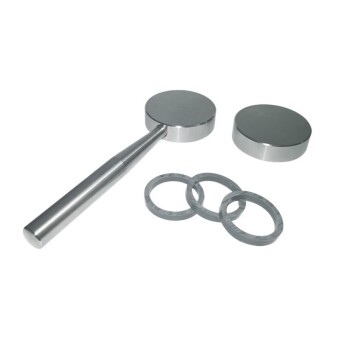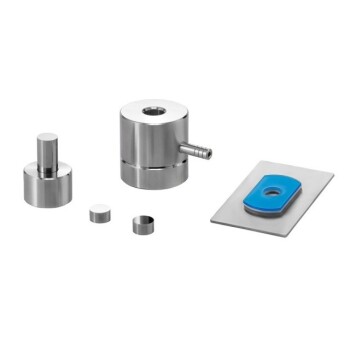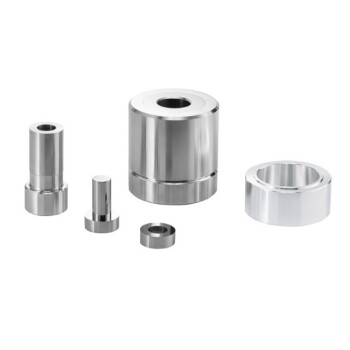To achieve accurate X-ray fluorescence (XRF) analysis, creating a high-quality pressed pellet is non-negotiable. The key considerations involve grinding the sample to a fine and uniform particle size, choosing an appropriate binder, maintaining a consistent sample-to-binder dilution ratio, and applying sufficient pressure to create a dense, homogeneous pellet with a perfectly flat surface for analysis.
The quality of your XRF data is a direct reflection of the quality of your sample pellet. Think of the pellet not just as a sample holder, but as the first critical component of your analytical instrument—its physical consistency is paramount for achieving analytical precision and accuracy.
The Foundation: Achieving Sample Homogeneity
The primary goal of pelletising is to transform a potentially heterogeneous bulk sample into a perfectly uniform analytical target. Any inconsistency in the pellet will introduce errors before the X-rays even hit the sample.
Why Particle Size Is Critical
A sample's composition can vary significantly from one particle to the next. Grinding the sample into a fine, consistent powder ensures these different particles are distributed evenly throughout the pellet.
This process minimizes what are known as particle size effects, where larger particles can disproportionately absorb or fluoresce X-rays, skewing the final elemental results. Think of it like trying to measure the average color of a mosaic; you get a more accurate reading from finely ground pigments than from large, distinct tiles.
The Grinding Process
For most materials, especially hard or brittle geologic samples, the goal is to grind them into a powder that feels as fine as flour. This ensures optimal distribution when mixed with a binder and pressed.
The Role of Binders and Dilution
While some pure powders can be pressed directly, most samples require a binder to create a durable, stable pellet.
Choosing the Right Binder
A binding agent, such as cellulose wax or boric acid, acts as a glue to hold the sample particles together under pressure.
The ideal binder is composed of very light elements (like H, C, O) that are not detected by most XRF spectrometers. This ensures the analysis focuses solely on the elements within your sample, not the binder itself.
Maintaining a Consistent Dilution Ratio
Mixing your sample with a binder is a dilution. It is absolutely critical that this sample-to-binder ratio (e.g., 20% binder to 80% sample) is kept identical for all samples and standards in a given analytical run.
This consistency minimizes the matrix effect, where the overall composition of the sample influences the X-ray signals. By surrounding the sample particles in a uniform matrix of binder, you standardize this effect, making results across different samples comparable.
The Mechanics of Pressing
The press is what transforms the prepared powder into a solid, analysis-ready disc. The force applied is a critical variable.
Applying the Correct Pressure
Most samples form excellent pellets when pressed at a load between 15 and 35 tons. This immense pressure works to eliminate voids between particles.
The goal is to create a highly dense and non-porous pellet. A smooth, solid surface ensures that the X-ray beam interacts with the sample uniformly, preventing signal scattering caused by surface imperfections.
Controlling Pellet Thickness and Density
A consistent pressing force and sample mass will produce pellets of consistent thickness and density. This is important because it ensures a standardized path length for the X-rays, improving the repeatability of your measurements. For some analyses, the pellet must be "infinitely thick" to the X-rays of interest, meaning it's thick enough that the beam doesn't penetrate all the way through.
Using Support Cups
For samples that are brittle or difficult to press, an aluminum pellet cup provides structural support. The powder is pressed directly into the cup, which holds the fragile pellet together and provides a rigid, flat backing for analysis.
Understanding the Trade-offs and Common Pitfalls
While pellet pressing is a standard technique, it involves compromises and requires careful attention to detail to avoid errors.
Binders: A Necessary Compromise
Binders are essential for creating durable pellets and mitigating matrix effects, but they also dilute your sample. This dilution lowers the concentration of every element, which can raise the detection limits and make it harder to quantify trace elements.
The Pervasive Risk of Contamination
Contamination can be introduced at any stage. Grinding equipment can shed metallic particles into the sample, binders can have impurities, and poor handling can introduce dust or other debris. Using high-purity grinding materials (like agate or zirconia) and certified binders is crucial for high-sensitivity analysis.
Manual vs. Automated Pressing
A manual press is a cost-effective solution for labs with low throughput. However, it relies entirely on the operator to apply consistent pressure, making it prone to variability.
An automated press provides exceptional consistency and high throughput by precisely controlling the pressure and duration of the press cycle. This removes operator-to-operator variance but represents a higher initial investment.
Optimizing Your Pellets for Your Goal
The ideal pelletising strategy depends on your specific analytical needs. Use these guidelines to make the right choice.
- If your primary focus is high-throughput production analysis: Prioritize an automated press and a standardized, well-documented procedure with a fixed binder ratio to ensure maximum consistency and repeatability.
- If your primary focus is trace element analysis: Minimize the binder ratio (or press neat, if possible) to maximize signal, and use high-purity grinding and binding materials to avoid contamination.
- If your primary focus is method development or a budget-constrained lab: A manual press is sufficient, but you must implement rigorous protocols for recording sample weight, binder weight, and applied pressure to maintain data integrity.
Mastering the art of pellet preparation gives you direct control over the quality and reliability of your analytical results.
Summary Table:
| Consideration | Key Details |
|---|---|
| Particle Size | Grind to fine, uniform powder to minimize particle size effects and ensure homogeneity. |
| Binder Choice | Use light-element binders (e.g., cellulose wax) to avoid interference and ensure durability. |
| Dilution Ratio | Maintain consistent sample-to-binder ratio (e.g., 80:20) to standardize matrix effects. |
| Pressing Pressure | Apply 15-35 tons for dense, non-porous pellets with flat surfaces to prevent signal scattering. |
| Contamination Control | Use high-purity materials (e.g., agate grinders) and certified binders to avoid impurities. |
| Press Type | Choose manual for budget/low throughput or automated for high consistency and repeatability. |
Elevate your XRF analysis with KINTEK's precision lab press machines! Whether you're conducting high-throughput production, trace element analysis, or method development, our automatic lab presses, isostatic presses, and heated lab presses deliver consistent, contamination-free pellets for reliable results. Don't let sample prep compromise your data—contact us today to find the perfect press for your laboratory needs and achieve superior analytical accuracy!
Visual Guide

Related Products
- Laboratory Hydraulic Press 2T Lab Pellet Press for KBR FTIR
- Laboratory Hydraulic Press Lab Pellet Press Button Battery Press
- Automatic Laboratory Hydraulic Press Lab Pellet Press Machine
- Manual Laboratory Hydraulic Press Lab Pellet Press
- Automatic Laboratory Hydraulic Press for XRF and KBR Pellet Pressing
People Also Ask
- What are some laboratory applications of hydraulic presses? Boost Precision in Sample Prep and Testing
- What are the advantages of using the hydraulic portable press for making KBr pellets? Achieve Superior FT-IR Sample Prep
- What are the main advantages of using hydraulic presses for sample preparation? Achieve Precise, Uniform Samples for Reliable Analysis
- How do hydraulic press machines ensure precision and consistency in pressure application? Achieve Reliable Force Control for Your Lab
- How is a hydraulic press used in sample preparation for spectroscopy? Achieve Accurate and Homogeneous Sample Pellets



















